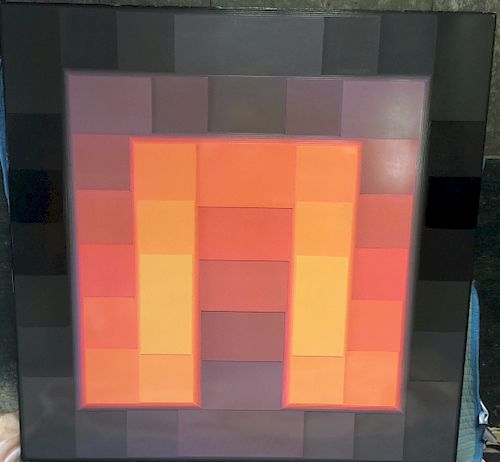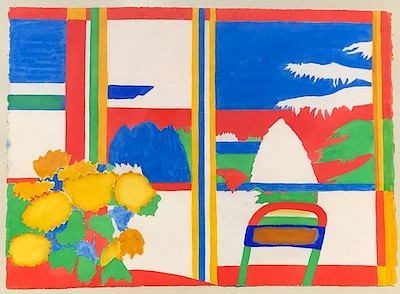Karl Gerstner (Swiss, 1930-2017) 1960's Modernist Masterpiece
Lot 1t
About Seller
Carlyle Galleries International, Inc.
9701 Wilshire Boulevard, 10th Floor
Beverly Hills, CA 90212
United States
Estimate:
$10,000 - $15,000
Absentee vs Live bid
Two ways to bid:
- Leave a max absentee bid and the platform will bid on your behalf up to your maximum bid during the live auction.
- Bid live during the auction and your bids will be submitted real-time to the auctioneer.
Bid Increments
| Price | Bid Increment |
|---|---|
| $0 | $10 |
| $50 | $10 |
| $100 | $50 |
| $500 | $100 |
| $2,000 | $250 |
| $5,000 | $500 |
| $10,000 | $1,000 |
| $25,000 | $2,500 |
| $100,000 | $5,000 |
| $500,000 | $10,000 |
About Auction
By Carlyle Galleries International, Inc.
Jul 19, 2018
Set Reminder
2018-07-19 13:00:00
2018-07-19 13:00:00
America/New_York
Bidsquare
Bidsquare : ART: European - Latin - Middle-East - Asian
https://www.bidsquare.com/auctions/carlyle/art-european---latin---middle-east---asian-3318
European, Latin, Asian, Middle Eastern, and American Art 1500's to Now. Paintings, Works on Paper and Sculpture Carlyle Galleries International, Inc. info@carlyle-auctions.com
European, Latin, Asian, Middle Eastern, and American Art 1500's to Now. Paintings, Works on Paper and Sculpture Carlyle Galleries International, Inc. info@carlyle-auctions.com
- Lot Description
Artist: Karl Gerstner (Swiss, 1930-2017) Title: “Color Relief No. 12” Medium: Nitrolack on phenolic resin plates, mounted on a wood supporting panel Size: 62“ x 62” inches (157.5 x 157.5 cm) Date: 1969 Condition: Overall good condition, with some minor scuffs and abrasions at the edges Notes: This monumental sized masterpiece, created in 1969, at the pinnacle of the artist’s career, showcases Gerstner’s mastery of color, form and materials, and is the largest work by Karl Gerstner to be ever offered at auction. Karl Gerstner (1930-2017) Born in Basel, Switzerland, Karl Gerstner was a critically acclaimed theorist, graphics designer, and artist, at the forefront of the mid-20th century’s most important art movements. Gerstner was the leading exponent of “Concrete Art”, which was intended to emanate "directly from the mind of the artist", with basic visual features such as planes, colors, and forms, with the artists “hand” being difficult to detect, and intended to appear as if made by a machine. The Concrete Art movement was popularized by Joseph Albers and Max Bill, and formed the basis for the “Op-Art” “Hard Edge” abstract painting. Gerstner was also an early pioneer in the “Programmatic” and “Computer Art” movements of the 1950’s and 1960’s, which are now gaining recognition and critical re-discovery. Karl Gerstner’s works were featured in the Museum of Modern Art’s "The Responsive Eye" show in 1965, alongside peers Vasarely, Carlos Cruz-Diez, Julian Stanczak, Kenneth Noland, Gene Davis, Richard Anuszkiewicz and other leading artist of this international movement. The MoMA also featured Gerstner in 1973’s “Designing Programs/Programming Designs: An Exhibition of Karl Gerstner”. Karl Gerstner’s work is widely represented in the MoMA’s collections, and other leading museums worldwide. Karl Gerstner made the conscious decision to work in several disciplines – as a graphic artist, painter and author. As a graphic artist and co-founder of the international advertising agency ‘Gerstner + Kutter’ and later of ‘GKK’, he was one of the leading figures of the successful “Schweizer Grafik” movement, whose work is epitomized in Gerstner’s iconic design of the Swissair logo. Rigorous intellectual theory, outlined in his many books, was the basis for Gerstner’s artistic work. His constant innovation, led to a body of work showcasing his experiments with form, color, materials, light, and video technology. Carlyle’s October 4 auction offers a rare opportunity for a private collector or institution seeking to own a masterpiece by this pioneering, and historically important artist. George Barrie (1912-2002) The work is from the estate of George Barrie (1912-2002) whose work in the 1960’s and 70’s placed him in the white-hot center of American pop culture. Born in Brooklyn, New York, Barrie taught himself the saxophone, clarinet, guitar and piano, and by age of 16 was performing with bands around New York. Finding it difficult to earn a steady living, as a musician, he became a salesman of haircare products. Eventually, he built his own hair care and fragrance company which became Faberge. Relentless experimentation, led George Barrie to develop a fragrance for men - “Brut”, and then use mass media, to popularize the idea of men wearing cologne (a rarity at the time). Barrie pioneered the use of celebrity endorsements to market a fragrance, and featured icons like Cary Grant, Roger Moore and Muhammad Ali, and Joe Namath in Brut advertising. Brut permeated the pop culture of the swinging 1960’s and 70’s . Elvis Presley was a fan, and known to have doused himself with the cologne which could be smelled from yards away, according to his friends. James Bond used an aerosol can of Brut, with a cigar, to improvise a blowtorch and dispatch a villain in “Live and Let Die”. By the 1970’s George Barrie’s attention turned to music and film, and he started Brut Productions, producing a string of successful films. Barrie gave screenwriter and director James Toback his directorial debut in “Fingers” starring Harvey Keitel, which was a breakout role for the actor. George Barrie collaborated with the legendary songwriter Sammy Cahn on numerous projects, and the pair earned two Oscar nominations for Best Song. Their song “All That Love Went to Waste” earned an Oscar nomination as the title song for A Touch of Class (1973) and Barrie earned a second nomination for Now that We're in Love from the film Whiffs (1975). Music was a major part of Barrie’s life: his gulfstream jet was equipped with an early electric piano, and his home and offices were filled with multiple piano’s, organs and “nearly every instrument known to man”. After selling Fabrege, Barrie retired to Aventura, Florida to hobbies including flying his private jet, and skydiving. The Karl Gerstner painting offered in Carlyle’s auction, was purchased by George Barrie circa 1970, at the behest of his friend, and Fabrege board member, Carrie Grant. The painting was displayed prominently in Barrie’s palatial apartment at 860 United Nations Plaza, an iconic New York building inspired by Mies van der Rohe’s “International Style”, and constructed in 1966. This was a unique alignment and dialogue of modernist art and design, and the apex of 1960’s American business and pop culture.
- Shipping Info
-
As a service and convenience, we can facilitate or recommend professional packing and worldwide shipping, and installation of your items through leading fine art transport companies. We do not ship any items.
Carlyle Auctions is not responsible for the acts or omissions of carriers or packers, whether or not recommended by us. Packing and handling of purchased items by us is at the entire risk of the purchaser. Costs for this service will be based on packing, transportation and insurance charges.In certain cases we may pack and ship very small items. In this event we will not be held responsible for any damage, or lost shipments.
-
- Buyer's Premium



 EUR
EUR CAD
CAD AUD
AUD GBP
GBP MXN
MXN HKD
HKD CNY
CNY MYR
MYR SEK
SEK SGD
SGD CHF
CHF THB
THB





